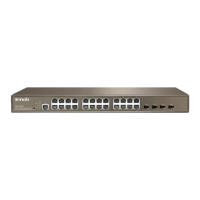User Guide
147
clients, so that it can relay DHCP broadcast messages to your DHCP server.
Data forwarding of DHCP relay agent is different from general routing forwarding. General routing
forwarding is relatively transparent and usually the transmitted IP packets won’t be modified. However, if
DHCP relay agent receives a DHCP packet, it will generate a new one and forward it out.
To the DHCP client, DHCP relay agent is DHCP server; to DHCP server, DHCP relay agent is the DHCP
client.
DHCP relay forwarding process:
DHCP relay working process:
When network devices with DHCP relay feature receive DHCP-DISCOVER or DHCP-REQUEST
packets broadcast transmitted by DHCP clients, the giaddr field will be filled with DHCP relay IP
and packets will be forwarded, using unicast, to the designated DHCP server according to
configurations.
According to the giaddr field, the DHCP server assigns IPs to clients and forwards configuration
info to clients via DHCP relay, and thus clients are dynamically configured.
Option 82
Option 82 records the location of the DHCP Client. Administrator can be acquainted with the location of
the DHCP Client via Option 82 so as to locate the DHCP Client for fulfilling the security control and
account management of Client.
When the DHCP relay receives DHCP request packets, the device will process them according to
process strategies of user configuration and whether option 82 is included or not.
This switch supports two sub-options: Circuit ID and Remote ID:
Sub-option 1(Circuit ID): the number of the port which receives the DHCP Request packets and
its VLAN number.
Sub-option 2(Remote ID): the MAC address of DHCP Snooping device which receives the DHCP
Request packets from DHCP Clients.
Operations supported for the Option 82:

